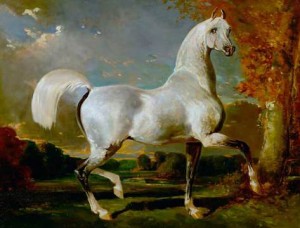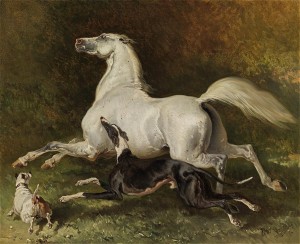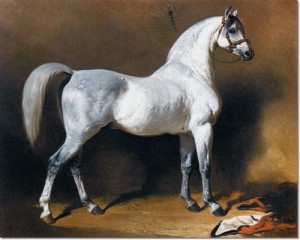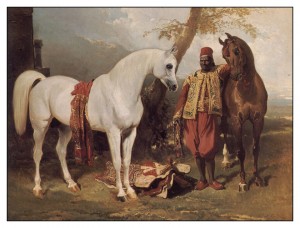For Thursday Art Day we re-visit ALFRED DE DREUX.
Alfred-de-Dreaux -Etalon Arabe
I blogged some time ago about ALFRED DE DREUX but I simply adore his work, hence the revisit and maybe again next week. Today I’m featuring some of his grey horses, next week some of his others. The more I see of Alfred de Dreux’s art the more I feel he would have to be one of the finest Romantic painters of thoroughbred horses, including the purebred Arabian. I have read that De Dreux painted portraits of the Duc d’Orléans’s horses and many racing scenes, but I think some of his best works are those, which show horses galloping or moving free. He has the ability to depict motion even if the horse is being ridden sedately by a lady riding side-saddle or a groom holding an Arabian poised to be mounted and ridden into the desert. There’s a marvellous elegance and an emphasis on the noble nature of the horse.
Alfred-de-Dreaux – A grey Arab stallion galloping with dogs
Personally ‘Etalon Arabe’ is a firm favourite. A grey Arab stallion emerging from a distant and storm building background is magical, the horses shining coat depicted with fluent brushstrokes immediately tells you about its power and speed. The painting ‘Grey Arab stallion galloping with dogs’ has the most wonderful sense of freedom and I love the elegant greyhound and the determined terrier as they race beside the horse. I hope you enjoy these paintings as much as I do…
Alfred-de-Dreaux – An Arab stallion
ALFRED DE DREUX
1810 – Paris – 1860
Alfred de Dreux was born in France, the son of an architect. He first studied with Léon Cogniet and then entered the atelier of Eugène Isabey. Throughout his career, however, de Dreux’s work was greatly influenced by Théodore Géricault (1791-1824), who was a close friend of his uncle, the painter Dedreux-Dorcey. Géricault painted de Dreux several times when he was a child. In 1831, de Dreux exhibited Interieur d’ecurie at the Paris Salon, which won him immediate fame. In 1840 he began his celebrated series of portraits of horses from the famous stables of the duc d’Orléans.
Alfred-de-Dreaux – The-mounts-of-Abd-El-Kader
Following the Revolution in 1848, the French royal family emigrated to England where de Dreux frequently visited them, painting many equestrian portraits of the exiled Emperor Napoleon III and his sons. He returned to France and was commissioned to paint a portrait of Napoleon III in 1859 (Musée de l’Armée, Paris). It was long rumoured that de Dreux was killed in a duel by Comte Fleury, Napoleon’s principal aide-de-camp, but Marie-Christine Renauld’s research has established that he died in Paris on 5th March 1860 from liver disease.
The work of Alfred de Dreux is represented in the Hermitage, St Petersburg; the Louvre, Paris; the Musée Camondo, Paris and museums in Bordeaux, Dijon and Chantilly.




Leave a Reply